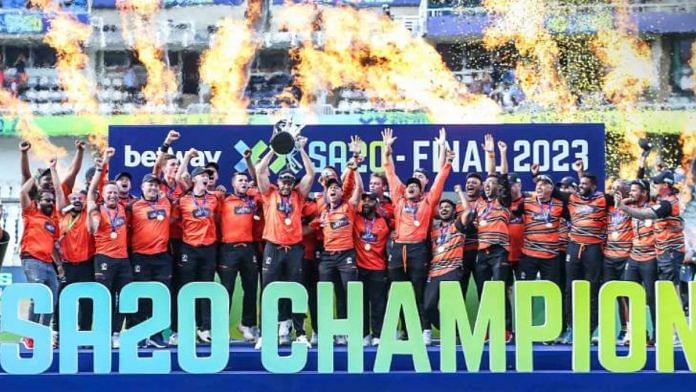Indian cricket fans might be amused to learn that the Indian Premier League has a South African clone. But they will hopefully be less happy to know that the tournament is a shop window for South African cricket’s racial biases.
The clone is the recently concluded SA20 tournament, in which all six teams are owned by and named after IPL franchises. Like the IPL and similar events around the world, it is meant to offer fans of the T20 format a festival of local talent and imported stars. But in South African cricket, almost three decades after white rule ended, ‘local talent’ means ‘local white talent.’
Racial bias in team selections
Racial bias is deeply embedded in South African cricket. White players are assumed to be skilled even when they clearly are not. Black players, which here includes anyone who would not have been classified ‘white’ during the Apartheid, including players of Indian origin, have to prove their merit — and are not always assumed to have it even when they do.
Makhaya Ntini, the third most successful Test match bowler in the country’s history, was selected only because a cricket administrator determined to end the white monopoly in the sport forced selectors to choose him. Hashim Amla, the only South African to score a triple hundred in Test cricket, was maligned for his so-called ‘lack of technique’. South Africa’s current premier fast bowler Lungi Ngidi faced an extreme backlash from retired white male cricketers for speaking up in support of the Black Lives Matter movement in 2020.
This bias has been softened by social pressure for teams to be more representative of a population in which only about 8 per cent are white. So, provincial franchises and the national team have a sprinkling (often a minority) of Black players.
But these restraints have largely been ditched for the SA20, a reality that became clear when Temba Bavuma—South African men’s cricket’s white-ball captain who led his team to draw a T20 series in India—was not offered a contract by any franchise. The organisers insisted that it was not them but the franchise holders who had excluded Bavuma. After much delay, he was drafted into a contract after scoring a hundred against England in an ODI match in January this year.
This excuse, that it was the Indian owners, not the South African power holders, who chose the teams was used to allow the SA20 to ditch much of the attempt to include the racial majority.
On an average, in the 33 matches played during SA20, each team fielded only two Black South African players. But one of the franchises, Paarl Royals, was an exception with five local Black players. In South African cricket’s racial architecture, whites do just about all of the batting, so the black players filled up the last five places in the batting order. In three matches, one of the teams had no local Black player and in 21 matches, teams took to the field with only one local Black player.
The tournament was saved from becoming a festival of whiteness by the presence of around a dozen Black players from other countries. But even the selection of foreign players showed a racial bias – most were white, mainly from England.
The imported complement might have more closely resembled the racial makeup of humanity if Indian players were available. But that might have been cancelled out by the likelihood that a plethora of Australians and New Zealanders would also have been drafted had they been available—only four were hired, presumably because their countries needed the players elsewhere.
Selecting foreign Black players also seemed to be an excuse to exclude local talent. Even in the dying days of white rule, it was common for the cricket authorities to hire West Indians to make their local tournaments seem a little less of a white club.
Also read: Play Pakistan, know Pakistan—why Indian cricket can’t afford to let go of the golden window
Shifting the blame
The claim that Indian IPL owners were responsible for the racial bias shown at SA20 is only partly true. The squads chosen by the franchises were more racially diverse than the teams they fielded—several local Black players included in the squad played only one or two games or none at all. Five of the six head coaches were white and it showed in their selections. The only coach who isn’t white is the one who fielded up to five Black players in his team.
But the Indian owners are not entirely innocent – there was a white bias in squad selections as well. This is not surprising since the IPL drafts of South African players have been biased toward whites. Hashim Amla was only drafted into IPL to replace an Australian, after which he scored two centuries, a particularly difficult feat in the T20 version of the game.
The worst example is the appointment of Mark Boucher by the Mumbai Indians as their coach in 2022. Boucher is a former South African player who has admitted to singing racist songs aimed at a Black teammate – his ‘apology’ was notable for its lack of remorse. Yet, he will now coach a squad of mainly Indian cricketers whose race he would probably have derided if they were playing alongside him.
Why would IPL owners repeat the racist practice of South Africa’s cricket establishment? The answer seems obvious. They don’t spend their time scouting the country’s domestic teams and rely on the advice of the South African cricket people they know—the same white people whose prejudices have limited the contributions of most South African cricketers for decades.
It is time that IPL owners widen their horizons to take in the views—and talents—of South Africa’s Black majority.
Steven Friedman is a Research Professor in Politics at the University of Johannesburg and a South African cricket fan. Views are personal.
(Edited by Ratan Priya)



